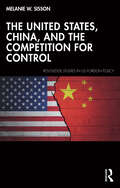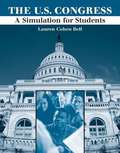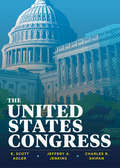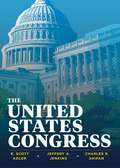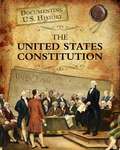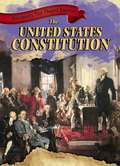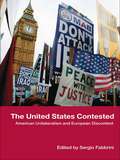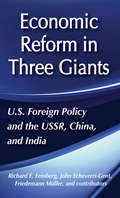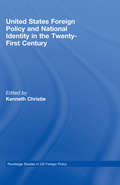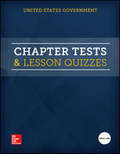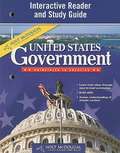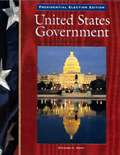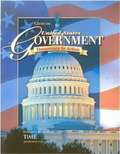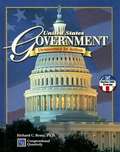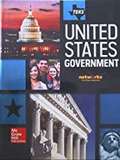- Table View
- List View
The United States, China, and the Competition for Control (Routledge Studies in US Foreign Policy)
by Melanie W. SissonThis book considers whether the United States and the People’s Republic of China have irreconcilable visions of world order.The United States, China, and the Competition for Control evaluates the twin claims that China seeks to dismantle the post–World War II international order and that the United States seeks to defend it. It defines the post–war order and examines how the United States and China have behaved within and in relation to it since 1945. An analysis of the two states’ rhetoric and policy reveals that their preferences for international order are not as divergent as today’s conventional wisdom suggests. The book therefore concludes that U.S. policies that treat China as a threat to international order are misplaced and offers policy recommendations for how the United States can both preserve the post–war order and protect its vital national interests.The book will be of interest to foreign policy practitioners, commentators, and analysts as well as students and scholars of security studies, international relations, and geopolitics.
United States Citizenship Student Text (Living in the United States Series)
by Kristina M. SwannUNITED STATES CITIZENSHIP, a component of the Living in the United States series, is an abbreviated version of traditional basal programs, written on Reading Level 3.0 - 4.5. The low reading level; sophisticated page layout; and age-appropriate visuals make each Student Text and accompanying activities appealing to struggling readers. The standards-based programs are appropriate for on-level students, students with learning differences, and students and adults reading below grade level. STUDENT TEXT - The full-color, 48-page Student Text features six easy-to-read chapters. Students will be able to explain the freedoms and responsibilities of U.S. citizens. Specifically, students will learn about the cultural makeup of the United States; principles of democracy; rights guaranteed by the Constitution and the Bill of Rights, such as due process rights; laws and important figures of the civil rights movement; voter qualifications such as citizenship, residence, and age; and more.
The United States Congress: A Simulation For Students
by Lauren Cohen BellSee Congress in action with THE UNITED STATES CONGRESS: A SIMULATION FOR STUDENTS! This student-friendly simulation guide provides you with the opportunity to learn new skills, such as Web-page design, legislative research and writing, and public speaking. The book includes tear out Worksheets, examples of legislation, Dear Colleague Letters, a Member's Daily Schedule, extensive reference materials, and advice for finding a job or an internship on Capitol Hill.
The United States Congress (First Edition)
by E. Scott Adler Jeffery A. Jenkins Charles R. ShipanAn accessible approach to a modern Congress course Drawing on their extensive teaching experience, Scott Adler, Jeff Jenkins, and Chuck Shipan bring current political science into the classroom in an engaging, accessible way. Driven by vivid examples and clear writing, this comprehensive book teaches students to critically analyze Congress’s role as a representative and governing body. It examines Congress' key rules, structures, and procedures and its dynamic interactions with other institutions.
The United States Congress (Second Edition)
by E. Scott Adler Jeffery A. Jenkins Charles R. ShipanThe new standard for a modern Congress course Scott Adler, Jeff Jenkins, and Chuck Shipan bring current political science into the classroom in an engaging and accessible way. Driven by vivid examples and clear writing, this comprehensive text asks students to think critically about Congress’s role as a representative and governing body; its key rules, structures, and procedures; and its dynamic interactions with other institutions.
The United States Constitution (Documenting U.S. History)
by Liz SonnebornLearn about the United States Constitution, one of the most significant documents in U.S. history. Find out about those who were involved in its creation and why studying this primary source is so important.
The United States Constitution: What It Says, What It Means
by Justicelearning. Org StaffAffordable, readable, and indispensable,The United States Constitution: What it Says, What it Means allows you to put the most important document in American history in your back pocket. In conjunction with Justice Learning and The Annenberg Foundation Trust at Sunnylands and with an introduction written by Caroline Kennedy and an afterword written by David Eisenhower, this pocket guide appeals to the broadest possible audience. Each Article and each Amendment is followed by a clear and concise explanation, in plain English, that is suitable for both middle and high school students. On December 8, 2004 President Bush officially signed Constitution Day into law. The law mandates that each year, on September 17th, schools and colleges that receive federal money are required to teach the Constitution. The new law was championed in Congress by Sen. Robert Byrd who famously carries around a copy of the document in his pocket. Sen. Byrd became increasingly alarmed at the lack of civics education-specifically relating to the Constitution-in our public schools and he wanted to take action. Lightweight, easy to use and easy for everyone to understand The United States Constitution: What it Says, What it Means is an excellent way for students and citizens of all ages to read and completely comprehend the building block of American democracy. Justice Learning (www. justicelearning. org), is a comprehensive on-line resource that offers wide-ranging non-partisan materials relating to civics education.
The United States Constitution (Documents That Shaped America)
by Therese SheaDescribes the events surrounding the drafting and ratification of the U.S. Constitution, and looks at how it provides structure for the nation's government.
The United States Contested: American Unilateralism and European Discontent
by Sergio FabbriniWhy and how is America contested by Europe? This new book answers this question and contributes to a better understanding of contemporary transatlantic tensions. Adopting different theoretical perspectives, the leading contributors to this volume assess the European discontent with America and relate this to the unilateral turn of US foreign policy in the twenty-first century. American unilateralism is interpreted by all the authors as the expression of a new conservative nationalism which has been growing in the country since the 1970s and became culturally hegemonic after 9/11. They explore the following key areas: the rise of American conservative nationalism US foreign policy transatlantic relations anti-Americanism the Iraq War the future of American political and cultural hegemony. This book will be vital reading for students of international relations, foreign policy analysis, American and European politics.
United States Foreign Policy and Economic Reform in Three Giants: The U.S.S.R., China and India
by Richard E. FeinbergThree of the largest and strategically most important nations in the world -the Soviet Union, China, and India - are currently in the throes of historic change. The reforms in the giants are transforming global economic and geopolitical relations. The United States must reexamine central tenets of its foreign policy if it is to seize the opportunities presented by these changes.This pathbreaking volume in the Overseas Development Council's series analyzes economic reform in the giants and its implications for U.S. foreign policy. Each of the giants is opening up its economy to foreign trade and investment. What consequences will this have for international trade? Each giant is attempting to catch up to global technological frontiers by absorbing foreign technologies: In what areas might cooperation enhance American interests, and in what areas must the U.S. protect its competitive and strategic assets? What role can key international economic institutions play to help integrate the giants into the international economy? The contributors suggest how U.S. foreign policy should anticipate these new circumstances in ways that enhance international cooperation and security.Contents: Overview: Economic Reform in the Giants and U.S. Policy, by Richard E. Feinberg, John Echeverri-Gent, and Friedemann Miiller; Economic Reform in the USSR, by Friedemann Miiller; Economic Reform in China, by Rensselaer W. Lee III; Economic Reform in India, by John Echeverri-Gent; The Politics of Economic Reform in the Giants, by John Echeverri-Gent, and Friedemann Miiller; Economic Reforms and International Trade, by Thomas Naylor; Technology Transfer to the Giants: Opportunities and Challenges, by Richard P. Suttmeier; and The Geopolitical Consequences of Reform in the Giants, by Elena Borisovna Arefieva.
United States Foreign Policy & National Identity in the 21st Century (Routledge Studies in US Foreign Policy)
by Kenneth ChristieExamines the complex relationship between United States foreign policy and American national identity as it has changed from the post-cold war period through the defining moment of 9/11 and into the 21st century. Starting with a discussion of notions of American identity in an historical sense, the contributors go on to examine the most central issues in US foreign policy and their impact on national identity including: the end of the Cold War, the rise of neo-conservatism, ideas of US Empire and the influence of the 'War on Terror'. The book sheds significant new light on the continuities and discontinuities in the relationship of US identity to foreign policy.
United States Government: Democracy in Action, Vocabulary Activities
by McGraw-Hill EducationThe United States Government: Democracy In Action Vocabulary Activities booklet helps students master unfamiliar words and terms used in the student textbook. The worksheets emphasize identification of word meanings and provide visual and kinesthetic reinforcement of language skills. Vocabulary practice typically involves matching activities, sentence completion, word puzzles, and sentence construction.
United States Government: Our Democracy, Chapter Tests and Lesson Quizzes
by McGraw-Hill EducationNIMAC-sourced textbook
United States Government: Principles in Practice (Interactive Reader and Study Guide with Answer Key)
by Holt Mcdougal Publishing StaffInteractive Reader and Study Guide with Answer Key
United States Government (HMH Social Studies United States Government Series #Student Edition 2018)
by Houghton Mifflin Harcourt StaffThe U.S. Constitution outlines six fundamental principles that have guided American government for more than 200 years. The Framers of the Constitution established these six principles-popular sovereignty, limited government, separation of powers, checks and balances, judicial review, and federalism-as the basis of our national government.
United States Government: Democracy in Action, Reading Essentials & Study Guide
by Glencoe Mcgraw-HillStudent Workbook. The Reading Essentials and Study Guide is designed to help you use recognized reading strategies to improve your reading-for-information skills.
United States Government: Democracy In Action
by Richard C. RemyUnited States Government: Presidential Election Edition
United States Government: Democracy in Action
by Richard C. RemyThis book provides a "behind-the-scenes" look at Washington never before available in any government program.
United States Government: Democracy in Action
by Richard C. RemyFEATURING COAUTHORSHIP BY CONGRESSIONAL QUARTERLY. Thanks to the partnership between Glencoe and Congressional Quarterly, this book provides a "behind-the-scenes" look at Washington never before available in any government program.
United States Government
by Richard C. Remy Donald A. Ritchie Lena Morreale ScottFEATURING COAUTHORSHIP BY CONGRESSIONAL QUARTERLY Thanks to the partnership between Glencoe and Congressional Quarterly, this program provides a " behind-the-scenes" look at Washington never before available in any government program.
United States Government
by Richard C. Remy Donald A. Ritchie Lena Morreale Scott Megan L. HansonUnited States Government and History textbook.
United States Government
by Jane W. Smith Carol SullivanWelcome to a study of United States government. You may be asking yourself, "Why do I need to know about the different branches that make up the U.S. government?" Part of being a responsible U.S. citizen involves learning about the country's government and understanding how it works.
United States Government: Democracy in Action, Guided Reading Activities
by McGraw-Hill StaffThe United States Government: Democracy in Action Guided Reading Activities provides activities for students who would benefit from a review of the material. By focusing on key information and concepts, Guided Reading Activities help students to understand and make appropriate connections among the ideas and facts they encounter in the student text.
